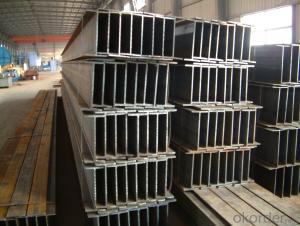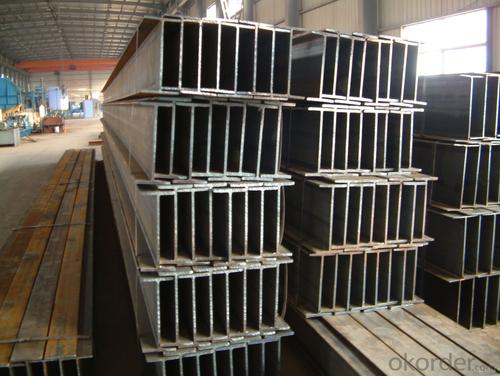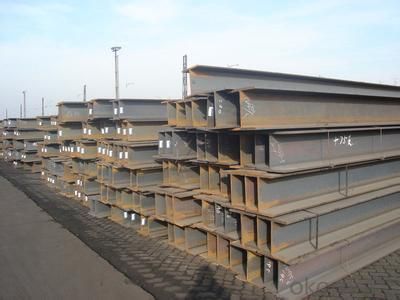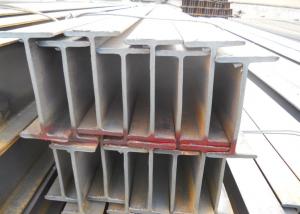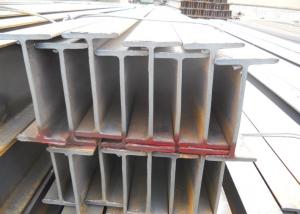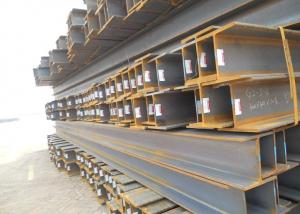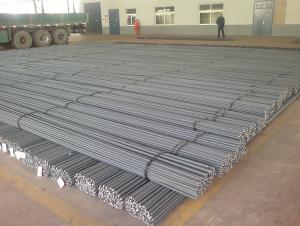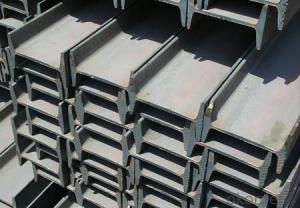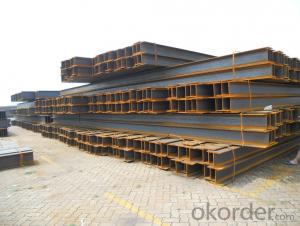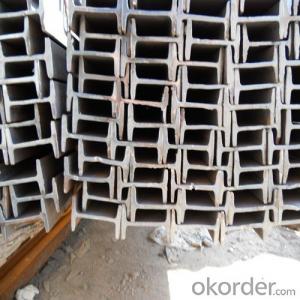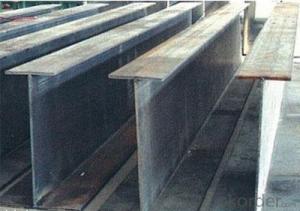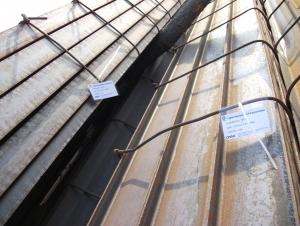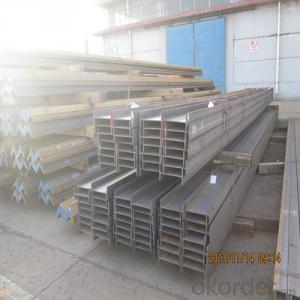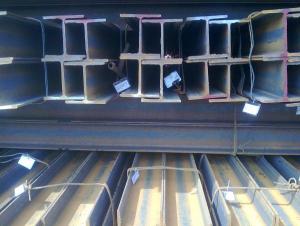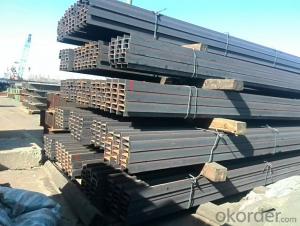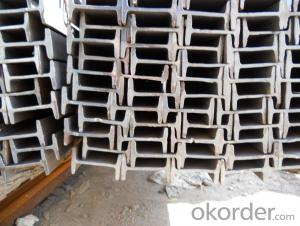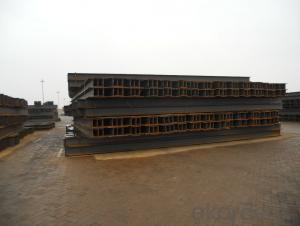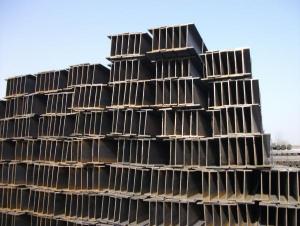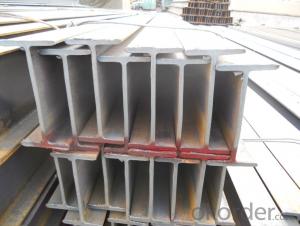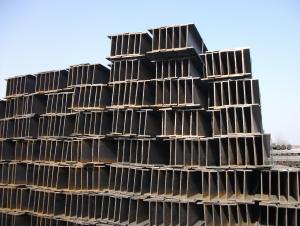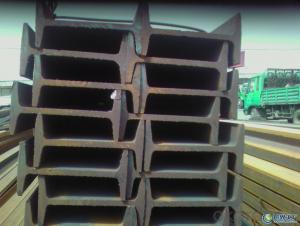Hot Rolled Metal Steel H Beams
- Loading Port:
- China Main Port
- Payment Terms:
- TT or LC
- Min Order Qty:
- 100 m.t.
- Supply Capability:
- 10000 m.t./month
OKorder Service Pledge
OKorder Financial Service
You Might Also Like
Product Description:
OKorder is offering Hot Rolled Metal Steel H Beams at great prices with worldwide shipping. Our supplier is a world-class manufacturer of steel, with our products utilized the world over. OKorder annually supplies products to African, South American and Asian markets. We provide quotations within 24 hours of receiving an inquiry and guarantee competitive prices.
Product Applications:
Hot Rolled Metal Steel H Beams are ideal for structural applications and are widely used inindustrial plants, civil construction, municipal works, oil platforms, bridges, flatbed beams, electrified railway power stand, railway bridges and other light steel structure, super-light H-beam is ideal for containers, mobile homes , all kinds of garage, box-type trains, electrical bracket, various venues, small villa manufacturing etc.
Product Advantages:
OKorder's Hot Rolled Metal Steel H Beams are durable, strong, and wide variety of sizes.
Main Product Features:
· Premium quality
· Prompt delivery & seaworthy packing (30 days after receiving deposit)
· Can be recycled and reused
· Mill test certification
· Professional Service
· Competitive pricing
Product Specifications:
Manufacture: Hot rolled
Grade: Q195 – 235
Certificates: ISO, SGS, BV, CIQ
Length: 12m, as per customer request
Packaging: Export packing, nude packing, bundled
SIZE(mm) | DIMENSION(kg/m) |
100*100 | 16.9 |
125*125 | 23.6 |
150*75 | 14 |
150*150 | 31.1 |
148*100 | 20.7 |
198*99 | 17.8 |
200*100 | 20.9 |
248*124 | 25.1 |
250*125 | 29 |
300*150 | 36.7 |
298*149 | 32 |
200*200 | 49.9 |
294*200 | 55.8 |
346*174 | 41.2 |
350*175 | 49.4 |
244*175 | 43.6 |
175*175 | 40.4 |
294*200 | 55.8 |
298*201 | 64.4 |
346*174 | 41.2 |
350*175 | 49.4 |
400*200 | 65.4 |
396*199 | 56.1 |
450*200 | 74.9 |
446*199 | 65.1 |
340*250 | 78.1 |
500*200 | 88.1 |
300*150 | 36.7 |
FAQ:
Q1: How many tons of steel products could be loaded in containers?
A1: Usually the steel products are delivered by bulk vessel because of the large quantity and the freight. However, there are no bulk vessel enter some seaports so that we have to deliver the cargo by containers. The 6m steel product can be loaded in 20FT container, but the quantity is changed according to the size, usually from 18tons to 25tons.
Q2: How do we guarantee the quality of our products?
A2: We have established an advanced quality management system which conducts strict quality tests at every step, from raw materials to the final product. At the same time, we provide extensive follow-up service assurances as required.
Q3: How soon can we receive the product after purchase?
A3: Within three days of placing an order, we will arrange production. The normal sizes with the normal grade can be produced within one month. The specific shipping date is dependent upon international and government factors, the delivery to international main port about 45-60days.
Images:

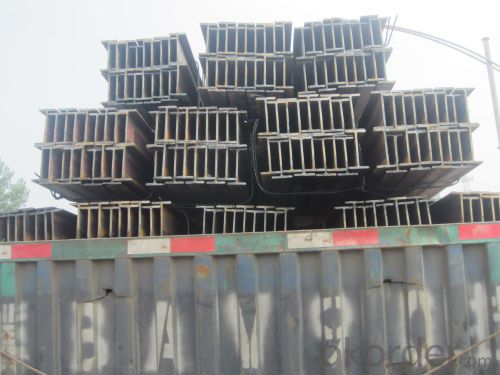
- Q: How do steel H-beams contribute to the overall sustainability of a structure?
- Steel H-beams contribute to the overall sustainability of a structure in several ways. Firstly, steel is a highly durable material that can withstand extreme weather conditions, seismic activities, and fire, which ensures the longevity and safety of the structure. This durability reduces the need for frequent repairs or replacements, minimizing the consumption of resources and waste generation. Additionally, steel H-beams are lightweight compared to other building materials like concrete or wood, which reduces the overall weight of the structure. This lightweight characteristic allows for more efficient transportation and construction processes, leading to reduced energy consumption and carbon emissions during construction. Moreover, steel H-beams are highly recyclable, making them a sustainable choice. At the end of a building's life cycle, these beams can be easily dismantled and recycled into new steel products without losing their inherent properties. Recycling steel reduces the demand for virgin materials, conserves energy, and reduces greenhouse gas emissions associated with the production of new steel. Furthermore, steel H-beams offer design flexibility, allowing architects and engineers to create innovative and efficient structures. Their versatility enables the optimization of material usage, reducing waste and maximizing the use of resources. This adaptability also facilitates the future adaptability of the structure, allowing for modifications or expansions without extensive demolition or reconstruction. Lastly, steel H-beams have a high strength-to-weight ratio, meaning they can support larger loads with less material. This efficiency in material usage reduces the overall environmental impact of the structure, as less steel is required to achieve the same structural integrity. Therefore, the use of steel H-beams in construction contributes to the conservation of resources and minimizes the carbon footprint of the building. In conclusion, steel H-beams contribute to the overall sustainability of a structure through their durability, lightweight nature, recyclability, design flexibility, and efficient material usage. By choosing steel H-beams, we can create structures that are not only safe and long-lasting but also environmentally friendly, conserving resources and reducing the carbon footprint of the construction industry.
- Q: Can steel H-beams be used in underground parking structures?
- Yes, steel H-beams can be used in underground parking structures. Steel H-beams are commonly used in construction due to their strength and durability. They are capable of supporting heavy loads and can withstand the pressure exerted by the weight of the structure above. In underground parking structures where space is limited, steel H-beams are a popular choice as they provide a high strength-to-weight ratio, allowing for efficient use of space. Additionally, steel H-beams can be easily fabricated and installed, making them a practical and cost-effective solution for underground parking structures.
- Q: Why is it that the steel pile is low in cost and easy to construct, and it can be changed when there is an obstacle
- This is the specification of hot-rolled narrow flange section steel.Cross section 300, flange width 150, web thickness 6.5, flange thickness 9.
- Q: Are steel H-beams suitable for swimming pool structures?
- Yes, steel H-beams are suitable for swimming pool structures. Steel H-beams are commonly used in construction due to their strength, durability, and versatility. They provide excellent support and stability for various structures, including swimming pools. Steel H-beams can withstand heavy loads and are resistant to corrosion, making them ideal for withstanding the constant exposure to water and chemicals in a swimming pool environment. Additionally, steel H-beams can be easily fabricated and customized to meet the specific design and size requirements of a swimming pool. Overall, steel H-beams are a reliable and efficient choice for constructing swimming pool structures.
- Q: Can steel H-beams be used in the construction of mixed-use buildings or complexes?
- Indeed, mixed-use buildings or complexes can utilize steel H-beams in their construction. These beams are highly valued in the field of construction due to their exceptional strength, durability, and versatility. They possess the capability to bear significant loads and offer outstanding structural integrity, rendering them perfect for constructing multi-story buildings or complexes with diverse functions such as residential, commercial, and office spaces. The design of steel H-beams is such that they evenly distribute weight along their length, thereby enabling the construction of vast open spaces without the necessity of intermediate columns or supports. This, in turn, empowers architects and designers to formulate adaptable floor plans and maximize usable space within the building. Moreover, steel H-beams exhibit resilience against various weather conditions and possess resistance to fire, pests, and rot, thereby ensuring long-term stability and safety for mixed-use buildings. Additionally, steel qualifies as a sustainable and eco-friendly building material as it can be recycled, thereby reducing its environmental impact. To summarize, the utilization of steel H-beams represents an exceptional choice for the construction of mixed-use buildings or complexes, thanks to their strength, durability, versatility, and ability to bear heavy loads. They facilitate architectural adaptability, provide long-lasting stability, and exhibit environmental sustainability, making them a preferred option for such construction projects.
- Q: How do steel H-beams perform in high-rise buildings?
- The construction of high-rise buildings often utilizes steel H-beams because of their exceptional performance under vertical loads and their ability to withstand high levels of tensile and compressive forces. These beams distribute the weight of the building evenly across their span, ensuring structural stability and support, ultimately allowing for the construction of taller and more efficient structures. A key advantage of steel H-beams in high-rise buildings is their impressive strength-to-weight ratio. This means they can bear heavy loads while remaining relatively lightweight, making them ideal for constructing tall buildings where weight reduction is crucial. Moreover, steel H-beams possess a high degree of flexibility, enabling them to bend and deform under extreme loads without compromising the overall integrity of the structure. Additionally, steel H-beams exhibit excellent fire resistance properties, which is particularly vital in high-rise buildings where fire safety is of utmost concern. Steel is inherently non-combustible and does not contribute to the spread of fire. Furthermore, these beams can be protected with fire-resistant coatings or encased in fire-resistant materials to enhance their fire resistance capabilities. In terms of construction efficiency, steel H-beams offer numerous benefits. They are prefabricated off-site, allowing for faster and more cost-effective installation. The manufacturing process ensures consistent quality and dimensional accuracy, which leads to reduced construction time and labor costs. This makes steel H-beams a popular choice for high-rise buildings where time and cost savings are critical factors. Another advantage of utilizing steel H-beams in high-rise buildings is their versatility. They can be easily customized and adapted to meet the specific design requirements of the structure. This flexibility allows architects and engineers to create innovative and aesthetically pleasing designs without compromising on structural integrity. Overall, steel H-beams are a reliable and efficient choice for high-rise buildings. Their high strength, fire resistance, construction efficiency, and versatility make them well-suited for withstanding the demanding conditions and loads experienced by tall structures.
- Q: How do steel H-beams contribute to energy-efficient building designs?
- The numerous benefits of steel H-beams make them crucial components in energy-efficient building designs. Firstly, their high strength-to-weight ratio allows them to support heavy loads while minimizing the steel required. This reduces the overall weight of the building's structure and foundation, resulting in energy savings during construction, transportation, and installation. Moreover, H-beams provide excellent structural integrity, ensuring the stability and durability of the building. They resist bending and twisting forces, allowing for the construction of larger spaces without excessive support columns or walls. The open web design of H-beams also facilitates the installation of insulation materials, enhancing thermal efficiency and reducing energy consumption for heating and cooling. Additionally, H-beams can be easily fabricated and customized to fit specific architectural designs. This enables architects to optimize the building's layout for natural lighting and ventilation. By incorporating large windows, skylights, and open spaces, energy-efficient buildings can maximize natural daylight and reduce the need for artificial lighting. Similarly, proper ventilation systems can be integrated, utilizing natural airflows to cool the building and decrease reliance on energy-intensive air conditioning. Furthermore, steel H-beams possess excellent fire resistance properties, critical for energy-efficient buildings. They withstand high temperatures and prevent fire spread, enhancing occupant safety and reducing the risk of structural damage. Consequently, the need for fireproofing measures, such as additional insulation or sprinkler systems, can be minimized, saving energy and resources in the long run. In conclusion, steel H-beams significantly contribute to energy-efficient building designs through their high strength-to-weight ratio, structural integrity, thermal efficiency, and versatility in design. Their fire resistance properties further enhance the safety and sustainability of these structures. By utilizing H-beams, architects and builders can create environmentally-friendly structures that promote energy conservation, reduce greenhouse gas emissions, and contribute to a more sustainable future.
- Q: Can steel H-beams be used for supporting industrial silos or storage tanks?
- Yes, steel H-beams can be used for supporting industrial silos or storage tanks. Steel H-beams are commonly used in construction and engineering projects due to their high strength and durability. They provide excellent structural support and can withstand heavy loads, making them suitable for supporting large and heavy structures like industrial silos or storage tanks. H-beams can be easily welded or bolted together to create a strong and stable support system, ensuring the stability and safety of the silos or tanks. Additionally, steel H-beams have the advantage of being resistant to corrosion, which is important in industrial environments where the storage of chemicals or other corrosive materials may occur. Overall, steel H-beams are a reliable and cost-effective choice for supporting industrial silos or storage tanks.
- Q: Are steel H-beams susceptible to fatigue?
- Yes, steel H-beams are susceptible to fatigue. Fatigue occurs when a material experiences repeated cyclic loading, leading to the growth of cracks and eventual failure. H-beams, being structural components subjected to various loads over time, can experience fatigue if not properly designed and maintained. Proper engineering considerations, such as selecting the appropriate steel grade, managing stress concentrations, and implementing regular inspections, can help mitigate fatigue issues in steel H-beams.
- Q: Can steel H-beams be used for sports arenas?
- Yes, steel H-beams can be used for sports arenas. They are commonly used for structural support in large and complex building projects, including sports arenas, due to their strength, durability, and ability to withstand heavy loads. The use of steel H-beams provides a reliable and sturdy framework for the construction of sports arenas, ensuring the safety and stability of the structure.
Send your message to us
Hot Rolled Metal Steel H Beams
- Loading Port:
- China Main Port
- Payment Terms:
- TT or LC
- Min Order Qty:
- 100 m.t.
- Supply Capability:
- 10000 m.t./month
OKorder Service Pledge
OKorder Financial Service
Similar products
Hot products
Hot Searches
Related keywords
